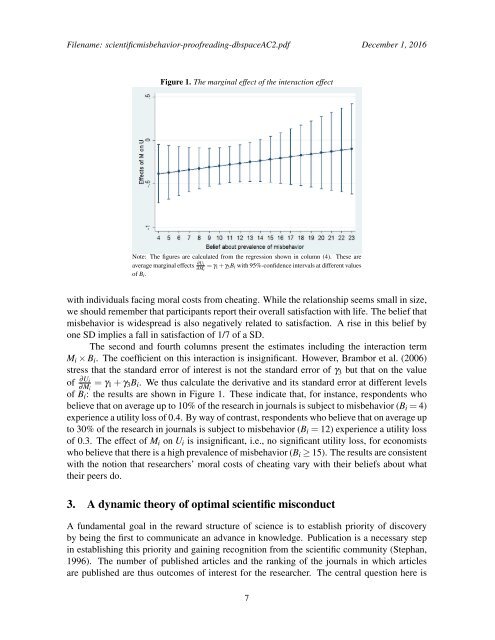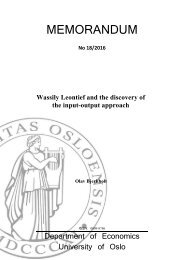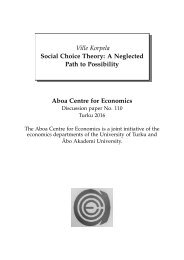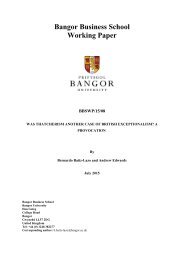Cheat Perish? A Theory Scientific Customs
n?u=RePEc:tut:cccrwp:2016-03-ccr&r=hpe
n?u=RePEc:tut:cccrwp:2016-03-ccr&r=hpe
Create successful ePaper yourself
Turn your PDF publications into a flip-book with our unique Google optimized e-Paper software.
Filename: scientificmisbehavior-proofreading-dbspaceAC2.pdf December 1, 2016<br />
Figure 1. The marginal effect of the interaction effect<br />
Note: The figures are calculated from the regression shown in column (4). These are<br />
average marginal effects ∂U i<br />
∂M = γ<br />
i<br />
1 +γ 3 B i with 95%-confidence intervals at different values<br />
of B i .<br />
with individuals facing moral costs from cheating. While the relationship seems small in size,<br />
we should remember that participants report their overall satisfaction with life. The belief that<br />
misbehavior is widespread is also negatively related to satisfaction. A rise in this belief by<br />
one SD implies a fall in satisfaction of 1/7 of a SD.<br />
The second and fourth columns present the estimates including the interaction term<br />
M i × B i . The coefficient on this interaction is insignificant. However, Brambor et al. (2006)<br />
stress that the standard error of interest is not the standard error of γ 3 but that on the value<br />
of ∂U i<br />
∂M i<br />
= γ 1 + γ 3 B i . We thus calculate the derivative and its standard error at different levels<br />
of B i : the results are shown in Figure 1. These indicate that, for instance, respondents who<br />
believe that on average up to 10% of the research in journals is subject to misbehavior (B i = 4)<br />
experience a utility loss of 0.4. By way of contrast, respondents who believe that on average up<br />
to 30% of the research in journals is subject to misbehavior (B i = 12) experience a utility loss<br />
of 0.3. The effect of M i on U i is insignificant, i.e., no significant utility loss, for economists<br />
who believe that there is a high prevalence of misbehavior (B i ≥ 15). The results are consistent<br />
with the notion that researchers’ moral costs of cheating vary with their beliefs about what<br />
their peers do.<br />
3. A dynamic theory of optimal scientific misconduct<br />
A fundamental goal in the reward structure of science is to establish priority of discovery<br />
by being the first to communicate an advance in knowledge. Publication is a necessary step<br />
in establishing this priority and gaining recognition from the scientific community (Stephan,<br />
1996). The number of published articles and the ranking of the journals in which articles<br />
are published are thus outcomes of interest for the researcher. The central question here is<br />
7





